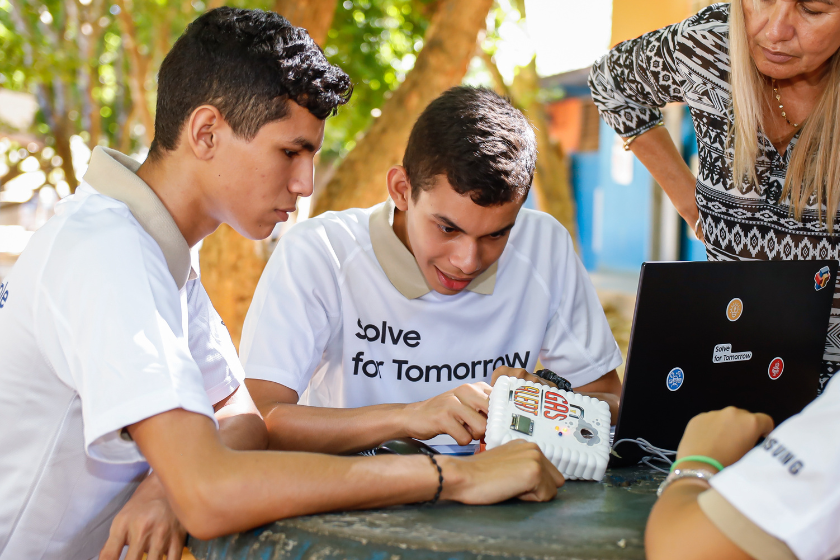In a community in the State of Nueva Esparta in Venezuela, intending to improve security in homes, a group of four students and the mediator teacher Leonor Jiménez managed to build a portable device that alerts with sounds, lights, and notifications on the phone when there is a gas leak. The project, titled Gas Alert, was a finalist of the 10th edition of Solve for Tomorrow – Central America and the Caribbean region, which brings together 11 countries: Dominican Republic, Costa Rica, Panama, Guatemala, Honduras, Nicaragua, El Salvador, Ecuador, Venezuela, Belize, and Barbados.
Because it is colorless and odorless, Liquefied Petroleum Gas (LPG) can represent a great danger. Composed of butane and propane, this gas is used by a large part of the Latin American population for various purposes, such as cooking. But gas leaks can cause fire, asphyxiation, or an explosion capable of destroying houses, buildings and causing fatal accidents. For this reason, student Gabriel Rodríguez thought about creating a prevention mechanism and brought together class colleagues and teacher Jiménez to put it into practice. “There is a community near where we live in which three casualties [accidents] had already occurred due to gas leaks and in one, a fifth-year student from another school died. That moved them because he was on the same grade as Gabriel and his colleagues,” the teacher recalls.
In the Gas Alert group, all the students are in the fifth year of general secondary education, the last of compulsory schooling in Venezuela, and they are 15 and 16 years old. The educator, who teaches Chemistry, had already registered for Solve for Tomorrow in 2022, with an electricity project, along with Gabriel and two other students, Jonny and Antonio. In 2023, they dedicated themselves to trying again, now with this new approach, and invited Yarielys. No one on the team had the technical knowledge necessary to make the detector, but that didn’t stop them. “Through pure Internet research, we have learned how every piece works,” she said.

After choosing the topic of gas leaks, the students began to investigate more, visualizing data on where there were accidents recently, how many, when, and what the reasons were. “They also interviewed engineers and each of them looked for information and that’s how the idea came together,” explains the teacher. Family participation was also essential, as one student’s mother introduced them to engineers, who were an important source of consultation throughout the project.
They already knew that the device should have audible and visual alerts. So they discovered the ideal types of sensors and lights for this and understood that they needed a wireless antenna and buzzer for the sounds. They also learned how to use the Arduino Nano, which is an open-source electronic prototyping board, and was the system chosen to process information, activate alerts, and send notifications. All of this is integrated into a Protoboard, which is a construction base that serves as a prototype of an electronic device, or as the teacher summarizes, it is like the brain.

The students then sought further and saw that there was another screen that could also work with this Protoboard. That was when the mood changed, says the teacher, reinforcing the message that we must continue looking for answers within a project like this.
Attention to detail
Another change made throughout the project was the colors of the device’s lights. At first, people thought of green, yellow, and red, like a traffic light. But in the end blue, yellow and red were chosen, as in the Venezuelan flag. Now, when the sensor detects the presence of gas, alerts are activated. When the blue light is on, it indicates a normal state, and the yellow light indicates that it is a preventive state and the red light means an alert state. In addition to the visual alerts, some sounds intensify according to the severity of the gas leak.
To expand the effectiveness of the device, the team concluded that it would be interesting to have notifications on the phone. Because, for example, if the detector is in the kitchen and the person is far away, they would not be able to see the lights or hear the sounds. So an application was created that notifies all alerts and reports how the gas concentration is where the device is.
After many tests, the group managed to create a device that was relatively easy to assemble and very useful for the population. They only created a prototype, but it is possible to reproduce it even commercially if there is interest. Ideally, the detector should be placed in spaces where gas is used, such as kitchens.
Youth Protagonism
The main success for the teacher was seeing the growth of the students. “I didn’t have to give all the guidelines, they were the ones who had the ideas, did the tests, and investigated until the final result,” she highlights. “You can say that they are other kids after the Solve for Tomorrow program. That experience motivated them and we intend to meet to start planning our next participation, in 2024,” says Jiménez.




